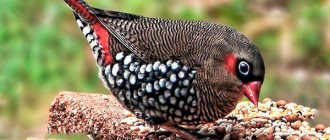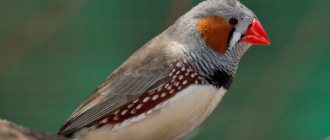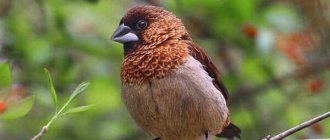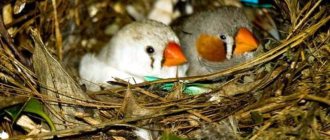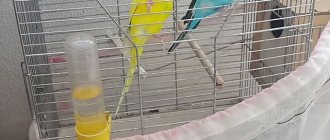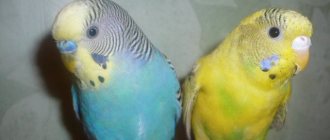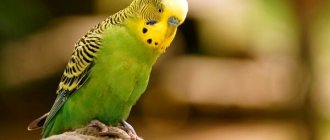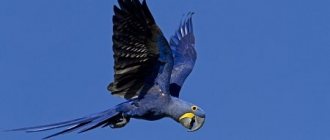Miniature finch birds as pets are an excellent alternative to small parrots. For example, zebra finches are one of the most popular songbirds. They are cheerful, noisy and active, but these qualities can not only delight us, but also irritate us. It is so interesting to watch the activities of finches, listen to expressive singing, and be touched by their touching care for each other. However, “minke whales” will never become tame, and in addition, they are aggressive towards birds of other species. We’ll talk about the most interesting features of zebra finches below.
The history of finches in cages
Finches are miniature birds that belong to the weaver finches family. There are more than 30 species of them in the world. These are heat-loving creatures, so they live mainly in Africa, Australia and Southeast Asia.
The Japanese finch was the first to be domesticated. This happened more than 400 years ago, as mentioned in historical materials. These birds appeared on the European continent much later, in the 18th century.
Interesting fact: the Japanese finch can be an excellent nanny for the chicks of other species, so they were often kept for this very purpose. Their ancestors lived on the Philippine Islands, from where they came to Japan and China.
At the same time as the Japanese birds, rice finches also found themselves in cages. They were discovered on the islands of Java and Sumatra, and later they spread to Southeast Asia.
Zebra finches and Gould's finches are native to Australia. The former often settle near human habitation, are not afraid of noise and are accustomed to being close to people. Data on keeping these birds in captivity date back to the second half of the 19th century. And in the twentieth century, zebra finches were already widely known in Western Europe.
Gould's finches were discovered by British naturalist John Gould in 1838-1840 during his travels in Australia. This species was named in honor of his wife Elizabeth, who accompanied her husband on the trip, but soon died. They were brought to Europe in 1887-1915.
What colors of birds would you like to breed (photo from the Internet):
black-faced black-breasted fawn lightback | black-faced silver lightback | black-faced black-chested orange-chested lightback | marmaset triblack continental marmaset triblack |
Appearance and description of the finch
Finches are cheerful, friendly and active birds with bright plumage. Despite the fact that they are songbirds, they do not sing in the best way. Their songs are similar to duck quacks.
The size of an adult is small, from 10 to 15 cm, weight up to 50 g. A distinctive feature of all finches is their beak. It has the shape of a slightly curved triangle, quite thick and transparent, as if made of wax. Because of this, finches are also called wax beaks. Chicks have black beaks, while adults have red or orange beaks.
In the wild, these birds live in large flocks. They always nest in pairs and lay from 2 to 4 eggs. Today there are 38 known species of finches, here are the most popular ones that you can have at home:
1. Zebra finch. It got its name from the striped color of the area from the beak to the crop. Birds can go without water for a long time, and drink much less than their fellow birds. They are quite noisy and active. This is the most popular type of house finches.
2. Japanese finch. They do not occur in nature, because... this species was bred artificially. Outwardly, they do not differ in bright plumage, but they have a friendly character.
3. Amadina Gulda. These birds have a very bright, rich color with clear contours of color transition. It is not easy to keep them at home, because they love warmth very much and cannot stand the cold. They are comfortable at a temperature of 25-30 degrees.
4. Rice finch. They like to be close to rice fields, hence the name. These are the largest finches, some individuals can grow up to 20 cm. They are noisy, and often behave aggressively with smaller birds.
Price, features of choosing a healthy bird
When choosing a feathered friend, first of all you need to pay attention to its appearance. A zebra finch can be considered healthy if it is moderately well-fed (without protruding chest), its feathers fit snugly to its body (no bald patches or ruffled areas), its eyes are shiny, and it generally behaves actively.
It is also worth inspecting the subclavian cavities of the bird for the presence of parasites and the feathers near the cloaca - they should be clean and not stuck together.
Attention! The best option for breeding would be a young individual (no older than 1 year). It is preferable to buy a finch in the fall to give it the opportunity to grow, get stronger and get used to its new home over the winter.
You can purchase a zebra finch from a private breeder for a price starting from 300 rubles. In the nursery, the cost is much higher - from 1,500 rubles, since here an Australian weaver will be provided with a pedigree and a veterinary passport with all vaccinations.
How to determine age
Determining the age of a zebra finch is quite simple if you know some of the characteristic features present in young individuals.
- They fly poorly and often lose coordination of movements, which is why they are inactive and mostly sit at the bottom of the cage.
- Young finches that have not yet moulted have smaller and duller feathers compared to mature individuals.
- They have delicate thin skin on their paws, covered with small, barely noticeable scales. The claws are small and neat. The beak is even more transparent than that of adult relatives.
Conditions for keeping and caring for finch at home
Caring for and maintaining finches at home is a responsible matter. After all, the health of the pet and its mood depend on this.
Since finches are school animals, it is better if they live in pairs; one bird can get sick and even die from boredom.
The cage should be quite spacious, approximately 60*40 cm, rectangular in shape. Finches are not comfortable in round cages; they begin to fly randomly and become restless.
Cage equipment:
1) wooden perches for each bird;
2) two drinking bowls;
3) feeders;
4) bath for bathing.
Finches are very clean, so the cage must be kept clean at all times. Feeders and drinkers should be washed up to 4 times a week, and drinking water should be changed daily.
These birds require certain living conditions. The temperature in the room where the birds live should be about 22 degrees. Finches love sunlight, so they need to be placed in such a way that the cage is in the light.
In the summer, you can take them out to the balcony for a while to warm up, but at the same time, make sure that the birds can hide in the shade from the sun's rays. In winter, you need to additionally illuminate the cage with a special lamp.
Amadins do not tolerate drafts and dampness well, this can even make them sick. The cage should be located away from strong and unpleasant odors, for example, tobacco smoke, nail polish, and so on.
The right time for breeding
Amadins in captivity are able to bear offspring at any time of the year. The incentive for finches to start breeding is an increase in daylight hours and an increase in temperature, so it is more convenient to plan the appearance of chicks for the summer period. In winter, in order to produce offspring, you will need to additionally illuminate the room with the breeders and ensure that there are no drafts.
Typical colors of finches
As we already know, there are many varieties of finches, and therefore their colors come in a variety of colors.
1. Zebra finches typically have ash-gray plumage and a red beak. Their cheeks are red, their belly is light, with a yellowish tint, and the craw area has characteristic horizontal stripes.
2. Japanese birds are inconspicuous in appearance. They are most often brown or cream in color, with a light belly and beak.
3. The drawings are ash-gray. The head and tail are black, the cheeks are white, the belly is gray-pink, the beak is red. There are also completely white individuals.
4. Gould's finches have bright, variegated colors that include blue, black, red, yellow, purple and green. There are black-headed, red-headed and yellow-headed finches.
Feeding finches at home
Let's figure out what to feed finches at home.
The basis of their diet is millet. Usually a special grain mixture is prepared to feed these birds. To 1 kg. Millet is added with 100 g of rapeseed, lettuce and chumiza, oatmeal, mogar and hemp. You can add 50 g of flax seeds and always meadow herbs (dandelion, clover, plantain, etc.), 200-250 g. For one bird, a teaspoon of this mixture per day is enough.
You can give finches porridge, vegetables, fruits and berries, but little by little. The pet menu should also include finely chopped eggs and cottage cheese, and during the breeding season - bloodworms, worms and other insects.
Don’t forget about mineral additives: chalk, sea or river sand, crushed eggshells.
Under no circumstances should finches be given aromatic herbs (dill, parsley, basil, etc.), this can lead to the death of the pet. Also, you should not feed your pets food for other poultry (canaries, parrots).
Incubation
After the appearance of a nest and clutches in it, it is interesting to find out how many finches hatch offspring. This period will last about 17 days. But this figure is approximate. You can subtract or add 1-2 days: the female does not lay the clutch immediately, but as soon as she collects 2-3 eggs. It is interesting to watch how finches hatch their offspring. They do it together - father and mother. While the female is sitting, he flies off to eat and drink. Then the birds change. If the female does not get up from the clutch, the male feeds her, bringing grains in his beak.
The owner should not worry at all if the finch laid an egg, and he does not know what to do in this case. Nature itself will tell the birds what to do.
If birds are hatching eggs, it is important that the room temperature is 20 °C. Its decrease threatens that in the absence of parents the masonry will cool down. Humidity should also be increased to 60%. This will prevent the eggshells from drying out and the chicks will hatch easily. The conditions for finches during the process of hatching eggs are the same as for other domestic parrots.
Breeding finches at home
Finches reproduce well in captivity, so if certain conditions are met, the offspring will not keep you waiting long.
During the mating season, a pair of finches is placed in a separate cage, where it is necessary to prepare a small house for them in which they will build a nest. You also need to provide the couple with building material to create a nest. These can be twigs, straw, dry grass, feathers, and so on.
After a week, the nest will be ready and the female will begin to lay eggs, usually from 2 to 4 pieces, but maybe up to 6. The male and female hatch the eggs in turns. In order for the breeding of finches at home to be successful, during the brooding period you should not disturb or frighten the birds by trying to look into the nest, otherwise the finches may abandon the clutch.
After 2 weeks, small chicks are born. Parents feed them from the crop, even after the chicks grow up and leave the nest. The babies live in the nest for three weeks, after which they grow up and leave it. And the parents can start laying eggs again. It is necessary to limit the number of nestings, otherwise the female may become exhausted and die from frequent clutches.
Amadina is considered an adult at one and a half months, and puberty occurs by six months.
Possible problems
One of the possible complications of breeding finches is the egg getting stuck in the female’s oviduct at the time of laying. This problem occurs in emaciated birds, with a lack of minerals and the presence of diseases of the internal organs. In the absence of timely assistance, the bird may die.
Some birds abandon their clutches if disturbed while incubating. In this case, it is necessary to remove the eggs and place them in an incubator or give them to foster parents with a well-developed brooding instinct, for example, Japanese finches.
Differences between male and female finch
To successfully breed finches, you need to be able to distinguish a male from a female, otherwise you can purchase same-sex birds at a pet store.
In some species of finches, sex differences are visible in color. Males usually have brighter plumage than females. For example, male zebras have orange-red cheeks, the typical zebra neck coloring, and brown flanks with white spots. Females don't have this, they are just grey. The beak of males is a richer red color, while that of females is paler, closer to orange.
Red-headed finches only have red heads on males. Chestnut-breasted males have a white belly and dark stripes on the chest and sides. Females have duller stripes and a gray belly.
There are species of finches whose gender cannot be determined by their plumage. Therefore, you need to listen to their singing. Males sing louder and more than females. Also boys are usually larger. Their beaks are brighter and larger than those of girls, and also have a slight hump.
Amadine chicks look the same, both males and females. They are light gray with black beaks. Only after two months will it be possible to determine the sex externally.
Compatibility of finches with other poultry and animals
Zebra and rice finches can be aggressive, especially during mating season. Even birds of the same species cannot always get along in the same cage, which can be said about other birds. Therefore, it is better not to share anyone with the finches, in order to avoid conflicts and fights.
It is also dangerous to keep them next to parrots, as they can bite the legs and fingers of finches, and this is a very serious injury for small birds.
If you have a spacious enclosure, then zebra finches can get along with Japanese finches, rice finches and canaries.
Life expectancy of finches at home
Before purchasing a feathered pet, you need to find out how long finches live at home. With proper care, they can live quite a long time, up to 10 years.
The main thing is to take good care of your pet, give balanced food, place the cage correctly, away from electrical appliances and sources of noise, provide enough light and protect it from cold and drafts.
If there is a dog or cat in the house, you need to make sure that the finch does not become prey for them. It is also worth making sure that the bird cannot fly out of an open window and take precautions.
Diseases of finches at home and treatment methods
When a bird lives with one owner for a long time and receives proper care, it rarely gets sick. Attention should be paid to recently acquired individuals and not to put them in a common cage, so as not to infect existing birds. You need to put the newbie away for a month and watch him.
What may alert you: lethargy and low activity of the bird, weight loss and lack of appetite, sounds and songs, changes in plumage, stool consistency. A sick finch can sit on a perch for a long time, ruffled, lumps and neoplasms may appear on the body, and often sneezes and yawns.
If these symptoms appear, take your pet to a veterinarian immediately for examination. Before that, you need to arrange for the finch to drink plenty of fluids.
The main diseases characteristic of finches:
1) diarrhea and intestinal inflammation (occurs due to poor quality and monotonous nutrition and an abundance of greens in the diet);
2) tracheal mite, signs: baldness, nasal discharge, rapid breathing, constantly open mouth;
3) eimeriosis, which mainly affects chicks (characterized by loose stools mixed with blood and mucus, convulsions or paralysis);
4) borreliosis, transmitted through tick vectors, characterized by fever, thirst, pale mucous membranes and paws, exhaustion.
To prevent many diseases, it is worth thoroughly cleaning the cage, periodically disinfecting it, and taking care of the birds’ hygiene and balanced diet.

